![]()
Student
Toronto, Canada
XX, 20XX
York Lions
Fall Term - Exams in December
.jpg)

Status: Feeling cold =( ^o^)ノ___o
 1 min
1 min
Status: Devious ←~(o `▽´ )oΨ
Haha @Niels Stensen, yeah no bueno.
 16 min
16 min
Status: Feeling hopeful.
There’s a huge wall of text on my feed, not surprising. I’d be more impressed if @Marielle Manansala wrote about how the Earth’s crust reveals geological events chronologically but I digress.
 32 min
32 min
Status: Serious.
Before I formally start, I want to preface that the explanation will be divided into a portmanteau way or in other words, 3 segments:
These will be started with an introduction and will end with a conclusion, akin to any analysis essay you might see about movies. What I’m trying to do here is replicate the format of most movie analysis and use it to explain the vast capabilities of waves. I figured that it would be fun, at least for me. If it’s a hit, I’ll consider writing another one about the law of superposition. Maybe. Regardless, please enjoy!
Fluvial is a term associated with processes involving moving water. Canada is definitely not a stranger to these processes as it’s considered to be the world’s largest coastal nation. What this means is that Canada is subjected to the forces of water and other coastal processes, ultimately resulting in varying landforms. Let’s investigate a bit further into coastal geomorphology together by understanding how waves and tides operate, how its formation takes place, and its other byproducts.
Waves, whether you define it in its physics or mathematical sense, just simply view it as water movement. Waves are essentially water movement caused by blowing wind on its surface. Within the process of waves, there is a cumulative effect that act on each other like dominos falling on each other:
Ultimately, all of these processes work together which then contribute to the gradual formation of the landscapes found in coastal environments.
These are a lot of terms, so feel free to take a minute. Below here, I've (poorly) illustrated three diagrams showcasing the characteristics and wave depths, respectively.

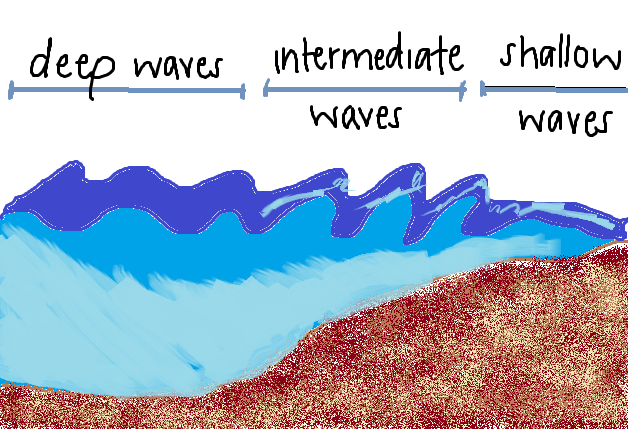
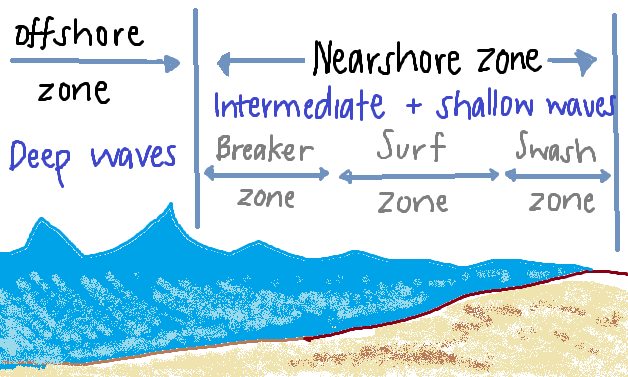
In addition, there are tides that are heavily correlated with waves. Tides refer to the waves caused by gravitational attraction from both the moon and sun, rather than wind. Just like waves, tides are one of the multiple factors that influence coastal locations and their resulting features.
I've also illustrated how this would look, which is found below.
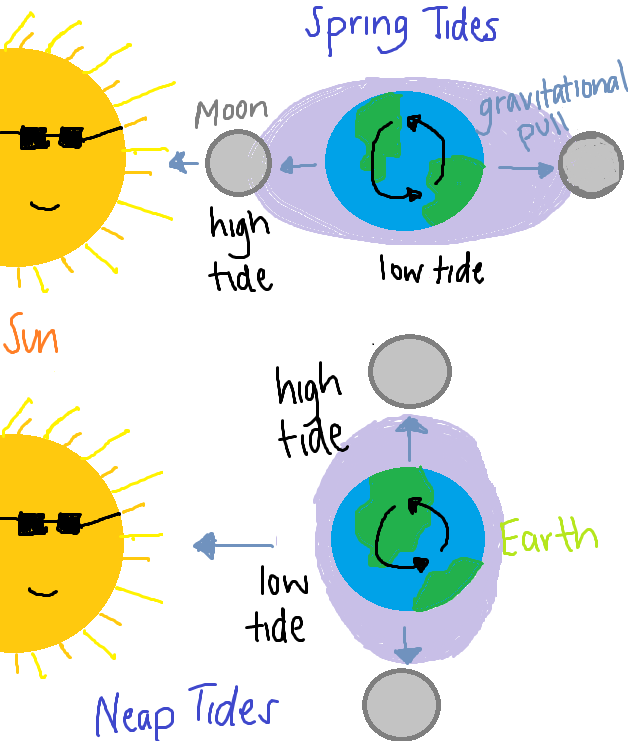
Now with that being established, tides are one of the multiple factors that influence coastal locations and their landscapes. Keep this in mind as I’ll come back to this.
The grand takeaway from this segment is that: Waves and tides are two of the main processes that influence coastal environments. Simply put, one process is affected by wind, whilst the other is influenced by gravitational attraction. When combining both processes together, the two contribute in forming landforms found in coastal environments and much more.
Still with me? Great, we're moving to the next segment about how waves, along with other processes, resulting in landforms.
One of the most notable features of coastal environments are beaches. I’m sure that everyone knows what a beach is and has their own unique experiences being there. However, in a geomorphological sense, beaches are defined as areas of sand and/or gravel deposition by waves, often along shorelines.
What’s responsible for such deposition? I’m glad you asked whoever-is-viewing-this-post! Let me backtrack a bit to the first segment and discuss why I mentioned all of those terms.
For landscapes to be created, it needs sediment of either consolidated bedrock or unconsolidated material. Particularly for beaches, it required unconsolidated sediment that is brought in by three main mechanisms: (1) wind, (2) waves, and (3) tides. Winds are more correlated with depositional processes, whereas both waves and tides are responsible for erosional processes.
With both processes combined, sediment is being accumulated that needs to be deposited into a coastal setting.
What happens to this sediment accumulation?
Gradually over time, this repeated action may result in that land strip of soft sand where everyone is preoccupied with just relaxing as the sun beams brightly, and immediately, you’ll think, “Oh, a beach.”
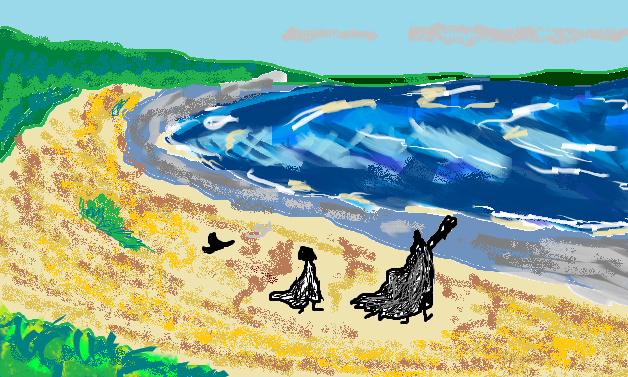
Obviously, this is simply an oversimplification - beaches are quite dynamic. It responds to its surroundings’ conditions based on its weather conditions, the intensity of currents, and seasonal changes. It becomes even more dynamic when you consider the other features caused by waves near beaches, or how there are different types of beaches.
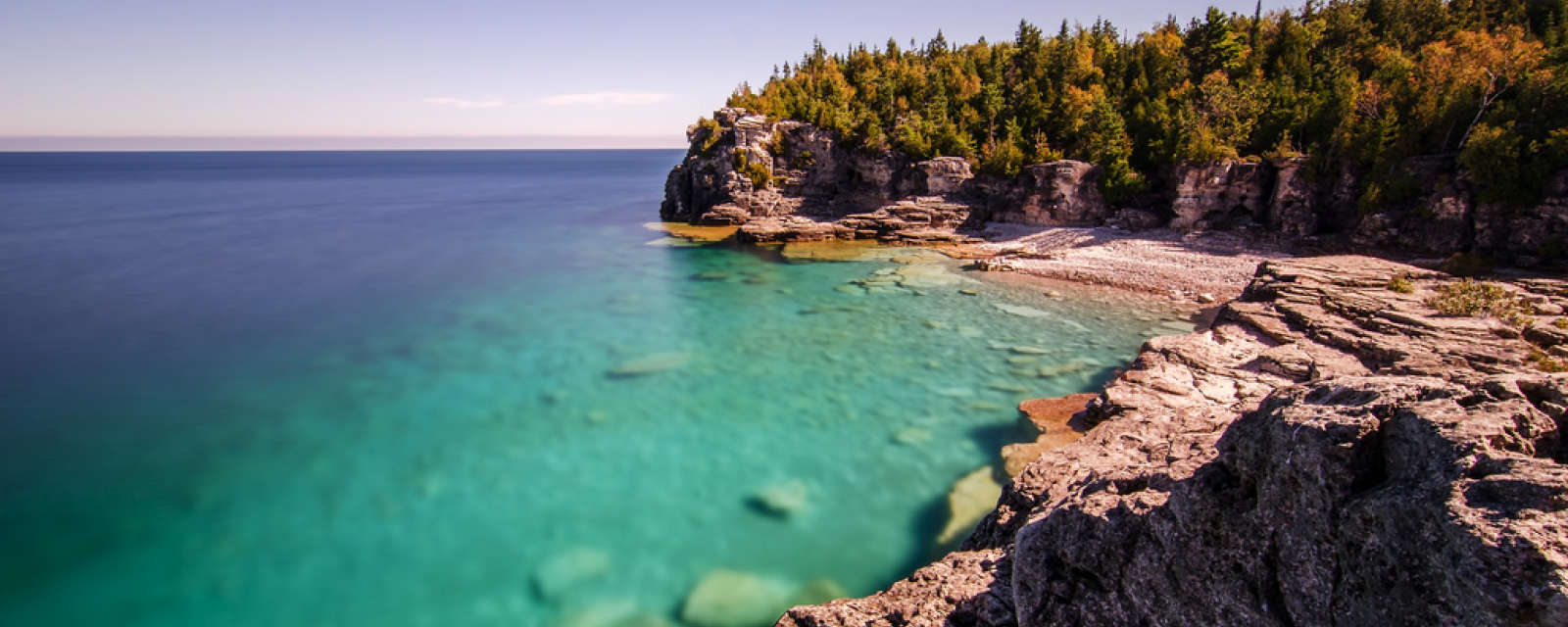

The grand takeaway from this new segment is that: Waves are considered to be the primary connection between water and land. Its continual motion between terrestrial and marine locations creates dynamic landscapes involving sediment accumulation, one of them including beaches.
When you think of waves, typically you’d obviously correlate them with beaches, which is the main reason why I created a whole segment dedicated to them. However, waves and tides are complex and have the capacity to create much more.
Waves/tides are heavily influential in creating features by sediment deposition. This is noticeable when looking at a beach profile, an overview of the beach landscape that encompasses areas above and below water and the area surrounding it. Aside from beaches, it can create various patterns along the beach and other landforms within the coastal environment.
Here are a couple of exmaples found within such coastal environments, which are all directly and/or indirectly affected by waves and tides:
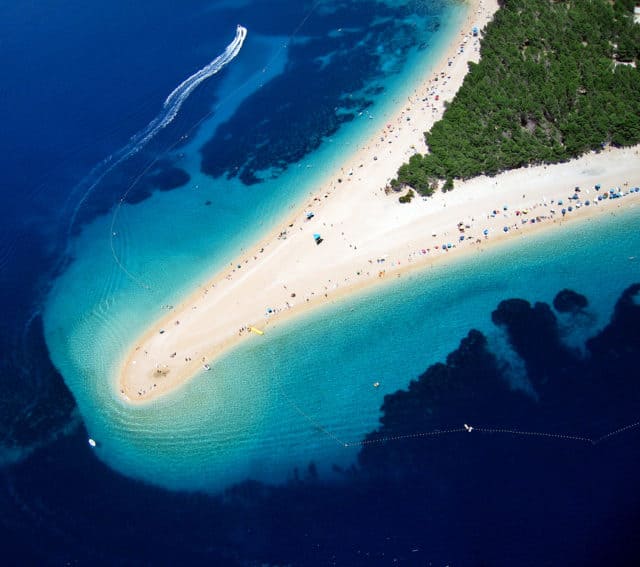
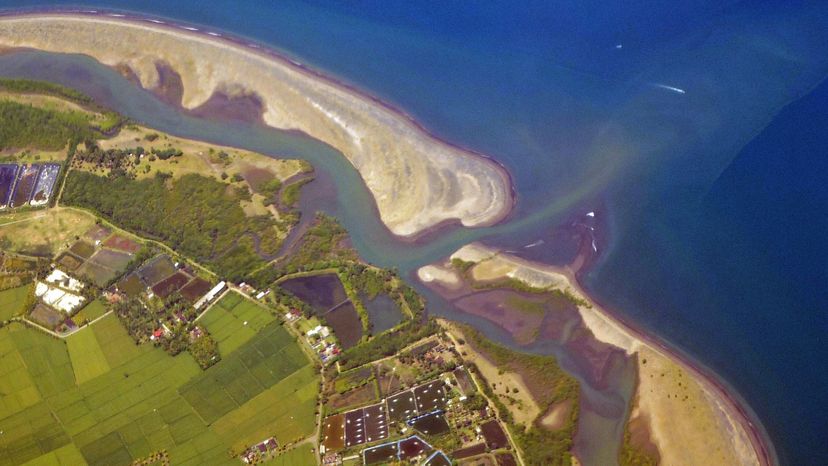
 Pretty cool huh?
Pretty cool huh?
My main takeaway from this: Look at me making a whole post about waves/tide processes. If you made this far, I’m flattered you stuck with me where I indulge in a topic that not many people are informed about. While I don’t expect that you all become geographers and whatnot, I just hope that this post will encourage you to take a look at the wonderful features that Ontario has to offer. Particularly for me, it was beaches and that led me to go down a rabbit hole and write this extremely long post about waves LOL. So next time you’re outside enjoying REAL nature, think about the complexities it took to create such features and landforms overtime :^)
Yup, that’s all I have to say. In case ya wanna skip everything and just want a little summary, here ya go -
 32 min
32 min
Status: Worried?
Hey, has anyone been able to scroll through their feed without having a whole wall of text block their way? I read that Marielle will be posting some explanation on waves soon… Perhaps they should write about the law of superposition instead...
 2 days
2 days
Status: Inspired ╰(°∇≦*)╮
Hey everyone! It’s been a while since I last posted. My movie review for Lost in Translation gained a small bit of traction surprisingly. What I thought was just a small blurb had evolved into a grand discussion of films and such. For those that contributed, it was a pleasure to read whatcha thought of the movie. However, for the people awaiting for another review, ya might have to wait a bit. Between balancing school and work, I suppose I haven’t found the time to just sit and watch a movie. It’s crazy, I mean watching movies is practically my thing. My peanut butter to my jam, my hot water to my teabag - what am i saying LOL
Anyways, it’s expected that I’d be preoccupied with other things as a university student. It’s just the way things are. I mean, I may be busy with homework and work but studying geography has really broadened my horizons. The lake that I pass by on my daily morning walk at the park, the distinctive pattern on the grassland that passes by me as I drive up to Northern Ontario, just the land surrounding me everywhere is viewed much more differently now that I understand its complexity. One of my classes talks about geomorphology, the study of Earth’s topography (shape and form) and its features along with it, and trust me - it’s interesting, interesting enough that saying some random facts about glaciers could break the silence in those ZOOM breakroom calls and have everyone say, “Oh wow, that’s crazy.” It’s probably not as deep as I’m making it seem but it’s enjoyable to understand things in depth. I’m gonna say it, I’ve grown to really appreciate landform evolution as much as I appreciate movies.
That brings me to my next topic, I’ve been out and about recently. With the quarantine regulations lessening over time, I took this to my advantage and decided to wander around Toronto. Throughout my journey, I’ve stumbled upon a lovely sight called “Sugar Beach” that was designed by landscape architect Claude Cormier. This beach is located near Toronto’s Waterfront and looks like how you’d expect it to look like, a beach. Clearly, this beach is just another project for urban revitalization, no doubt about it. Just the contrast between our jungle city of continuous buildings and this artificial attempt of a natural phenomenon made me think of Canadian landforms and how they came to be naturally.

More specifically, it made me think of the geomorphology caused by water systems (since I’m learning about this stuff in class)
Then I thought about how I haven’t been posting as of lately…
*light bulb moment*
How about I write about what I’ve been learning about? It’ll be a full-fledged explanation, almost like I’m writing a full movie review. I mean, what are the chances of you stumbling by a post simplifying the processes of fluvial systems? Would a normal person just scroll past this potentially large text block? Yeah, but who cares.
PLAN: write a whole run-through of how coastal landforms, specifically beaches, are formed.
RESULTS: walls of text about beaches, feeling of accomplishment for putting this geography knowledge to use, perhaps (if I’m lucky) 5 likes.
Gonna buy me another coffee. ಥ_ಥ
 12 days ago
12 days ago
Status: Tiredddddddddddddddddddddddd ಠ_ಠ
With the reading week coming to an end, I present to you a plethora of movies I’ve watched after doing all my necessary studying:
As much as I want to pour my soul and heart out in typing movie reviews that probably get more care and attention than my actual school essays, I’ll hold myself back. However, I’ll talk about Lost in Translation briefly.

Lost in Translation is an indie film directed by Sofia Coppola. Man, Coppola sets the nostalgic mood to the tee. The whole setup of the movie was as if I went to Tokyo circa 2003. Each frame was positioned ever so elegantly and that’s a feat that is close to Wes Anderson and Wong Kar-Wai’s level. Both the aesthetics and overall score of the film exceeded expectations and it all had a place. In regards to the mood of the film, the small intimate moments that Bob Harris (Bill Murray) and Charlotte (Scarlett Johansson) both shared in combination with the muted pastel palettes will absolutely bring this sense of loneliness??? out of you and that was great. However, ya gotta ignore the blatant racism if you really look into the movie. Admittedly, these observations will go unnoticed if you focus on the main two characters but then again, half of the movie involved them making fun of Japanese people by using them as props or a plot device, I’m not sure. I get that Coppola created this film as a homage to Japan but perhaps that too was lost in translation.
Regardless, go ahead and watch this. This movie’s great when the weather outside is a bit cold and foggy. DM me if you need a link to watch the movie illegally because… I mean… it saves money? LOLOLOL
ε=ε=ε=ε=┏(  ̄▽ ̄)┛ - me on the run when the movie police know that i have a super-secret site for free movies
Edit: Perhaps I should do more of these reviews. Hmmmmmmmm. I’ll post another once I get some time or something… or not… who knows? As for now, back to grinding in school.
I guess you could say “back to mining in school” Get it? Since I’m a geography major and mining is correlated to mountains which ties back to the land formation and land formation ties in with geography… It was funnier in my head. ┐( ̄ヘ ̄)┌
Edit: … I’ll see myself out, no need to comment “*throwing tomatoes, booing*”
 26 days ago
26 days ago
Hello! #firstpost
This is pretty exciting to finally post something here. I heard about this new website “NookFeed” and how it’s the new upcoming social media website that’ll take over the internet. It kinda looks like a bootleg Facebook, not gonna lie. It’ll probably just be a hit for us York Uni students. Perhaps I should give the creator some slack. I heard that she’s some sleep-deprived university student in the Environmental Science program.
Whelp. Kudos to her, I guess. I’m not that different haha, I too am an environmental science student studying geography and all that jazz.
With the whole pandemic occurring in 2020 and the closure of practically everything, it’s been tough in all aspects - financially, physically, emotionally, and mentally. While I love being in the comfort of my own home and the company of my family, I hope to branch out a bit and meet new people, even if it’s all just virtual.
Anyways, I’ll be straightforward. I’m gonna post a lot of stuff. This is gonna range from random reviews to random things I’ve noticed or stuff I find interesting. I mean, I hope so. There are not much users present on the site yet so I won’t feel too embarrassed about my continuous rambling.
Well, I’ll see you in my next post! d( > _・ )
Upcoming Events:

Assignment Due
Friday 23:59
Friend Request

ADS